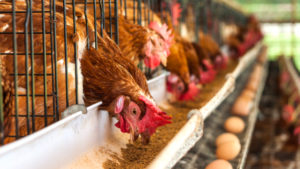Farmers have great significance for the regular disinfection of chicken cages. Correct and effective disinfection can kill the bacteria on the cages, so that the chickens can reduce the chance of infection, and they can also clean the chicken cage so that the chickens can breathe fresh Air, the poultry farm equipment suppliers will explain how to effectively disinfect the chicken cage.

1. Reasonable selection of disinfection drugs: The selection of disinfection drugs should be targeted, according to the purpose of disinfection, the target, the epidemic trend, and the principle of high efficiency, broad spectrum, economy, and small side effects. Different pathogenic microorganisms have obvious differences in their sensitivity to disinfectants. For example, the spore-forming microorganisms are less sensitive to disinfectants, so the concentration and action time of the drugs used must increase. Most disinfectants have an effect on bacteria, but have little effect on bacterial spores and viruses. Therefore, when eliminating infectious diseases, the characteristics of pathogenic microorganisms should be considered, and disinfectants should be selected correctly.
2. Maintain an appropriate temperature: In addition to flame disinfection which completely relies on temperature to kill microorganisms, other disinfection methods are also affected by temperature changes. The bactericidal efficacy of disinfectants is directly proportional to the temperature. As the temperature increases, the bactericidal efficacy increases, so the disinfection effect in summer is stronger than in winter. Disinfection in the high temperature season in summer can lower the house temperature by 3 to 4°C, prevent heatstroke and cool down the flock, and effectively reduce heat stress. In winter, the house temperature should be increased by 1~2℃ before disinfection to reduce the influence of disinfection and cooling. When the fumigation disinfection method is used, the disinfection effect will be reduced when the temperature is below 15℃, and the disinfection effect is best under the environmental temperature of 25℃~40℃.
3. Maintain proper humidity: The environmental humidity has a great influence on fumigation and disinfection, too high or too low humidity will affect the disinfection effect, and even cause disinfection failure. When using formaldehyde and peracetic acid for fumigation and disinfection, the humidity is required to be 60% to 80%. In addition, most disinfectants lose their disinfection effect after drying, and solution disinfectants can only function effectively when they are in solution. When the relative humidity is below 60%, the bactericidal power of ultraviolet rays is stronger. When the relative humidity is 80% to 90%, the bactericidal power decreases by 30% to 40%. This is because the increase in relative humidity will affect the penetration of ultraviolet rays.
Finally, remind everyone that the disinfectant used is irritating to the skin fur mucous membrane. Avoid contact with the skin. Wear acid- and alkali-resistant gloves when disinfecting. Wear a helmet when spraying fire alkali to prevent splashing into the eyes and causing conjunctival damage. . Formaldehyde vapor is very irritating. Open the doors and windows of the chicken house for more than two days after disinfection to dissipate the formaldehyde gas.